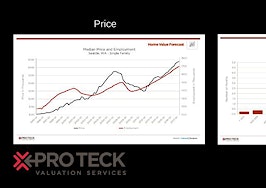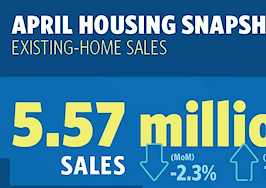- Though the nation is going through its third year of a chronic listings shortage, 10 percent of the 100 largest real estate metros are reporting more active listings now than they did a year ago.
- The positive inventory markets are made up of new home construction or the sales driven by falling rents or rising vacancy rates.
At the end of the first quarter, inventories fell to their lowest levels since the beginning of the recovery and fell to a 3.8 months’ supply by the end of March.
By April, tight supplies reached a point where they started crippling sales, which fell 2.4 percent. On a national basis, the total supply improved slightly in April, but the national inventory is still 9 percent below last year’s level, which was below the year before.
We are now in the third year of an inventory drought that echoes conditions at the peak of the boom 10 years ago.
National numbers are only aggregations of hundreds of markets, and they may be masking what’s going on at the ground level where people buy and sell homes.
One out of 10 of the nation’s 100 largest markets had larger numbers of active listings at the end of March than they did 12 months earlier. Some of them aren’t doing as well as they normally do, and are barely in the black. Two are flush with properties.
Why are some markets missing the misery and others are not? What can these fortunate metros tell us about how to cure the drought that has left the housing recovery dry and barren? Do they hold the key — or even clues — to a national inventory recovery?
Secrets of inventory-positive markets
Drawing on Q1 inventory data from realtor.com, which carries about 1.4 million active listings, 12 of the nation’s 100 largest markets report an annual increase in listings.
The multiple listing services for two markets, Denver and Pittsburgh, reported that their positive investor counts had turned negative in April, so they were eliminated from the list.
A cursory look at the list rings some bells. Palm Bay, Florida; Las Vegas; Cape Coral, Florida and Fresno, California; were all epicenters of the foreclosures that shook real estate markets following the housing bust in 2007.
Thousands of homes became rentals and diminished the stock of ownership properties. The inventory of single-family rental houses grew dramatically to 12 percent of all housing units in 2015, up from 9 percent in 2006. The vast majority of these are owned by small investors with fewer than 10 rental properties.
The Texas cities of Dallas, Houston, Austin and McAllen along with Tulsa, Oklahoma, are in a similar situation. They are centers of the oil industry boom (created by new technology like fracking) that took off in 2011. The boom created a large demand for housing.
Austin’s housing shortage was also generated by a boom in its technology industry. With the decline in oil prices, employment had fallen and housing demand had diminished temporarily, which helped inventories recover.
Sales are down 8.53 percent in Tulsa, and the decline in home values hit the housing market hard in McAllen. Today, McAllen ranks third in the national growth of underwater mortgages, up by 7,746 homes in the last quarter.
However, in addition to layoffs, positive inventories in Texas and Oklahoma owe more to another force: new construction.
The housing recession devastated homebuilders, and it has taken years for them to restock their supply of land and labor. The oil boom gave Texas builders a three-year head start in advance of the national housing recovery.
With fewer regulatory constraints than most other states and more time to ramp up production, Texas now leads the nation in permits issued and housing starts, which in April were up 26.7 percent quarter-over-quarter, the strongest showing in more than a decade.
Quarterly starts were up 4.6 percent in Dallas, 5.3 percent in Houston, and 5.8 percent in San Antonio. April new home sales in Austin, Dallas-Ft. Worth, Houston and San Antonio rose more than 17 percent over 2016.
MLSs serving markets like Dallas and Houston may also carry more new home listings in their inventories than other MLSs because of the success of HomesUSA, a platform for real estate agents to publish and manage builder inventory on the MLS.
Are single-family rentals coming to the market?
Four of the six markets on the positive inventory list are home to many single-family rentals. Rent and occupancy rates are critical factors for the landlords, and the landscape is changing for single-family rental (SFR) profitability.
Today, the top markets for SFR profitability are in Ohio, Pennsylvania, Upstate New York, and the Carolinas; not California, Arizona, Nevada and Florida of the foreclosure era seven years ago. Moreover, some analysts believe that single-family rental growth has surpassed its peak growth rate and is decelerating.
“It’s not clear that the economy and wages can continue to support the rapid rate of increase in rents that we’ve seen the past few years, which some single-family rental investors depend on,” ATTOM Data Solutions’ Daren Blomquist recently told National Real Estate Investor. “Tepid wage growth is far and away the most important limit on how much landlords can raise their rents.
“We do see several bellwether markets where rents were basically flat — such as the Inland Empire of Southern California and Orlando, Florida — or even fell on average. Rents fell 1 percent over the last year in Las Vegas,” he said.
An oversupply of rental properties can drive up the vacancy rate and eventually push rental rates down. High vacancies and falling rents are strong inducements to sell. Is that the case in the states where the single-family rental boom began?
Some clues:
In Florida last year, the highest fourth-quarter metro vacancy rates among houses for rent were 11.4 percent in Cape Coral-Fort Myers.
Last year rents fell 1 percent in Las Vegas.
Fresno SFRs fell 5 percent in July, ranking the city No. 7 nationally in biggest one-month price drops. By February, rents were up 2.2 percent but were falling in five local zip codes.
A bellwether?
Orlando didn’t make our list, but Blomquist cited it as a “bellwether” market, and it shows signs of joining the Florida markets where investors are selling. Like other Florida markets, it suffered a foreclosure flood and its booming, entertainment-based economy attracted international and institutional investors, like the Blackstone hedge fund.
To date, Orlando shows no sign of recovering from the inventory drought. Through April, its overall inventory of homes was 17 percent below levels of a year ago. There was 16.5 percent fewer single-family homes and 20.6 percent fewer condos. That’s one reason sales were 4 percent lower than a year ago.
It’s SFR effective rent growth is positive, growing at 4.8 percent in the fourth quarter of last year, but it is no longer a national leader in rental growth.
“I don’t see any softening or rents. It’s just the opposite. The rental market is doing extremely well. Do I see some cashing out? Yes, I do. Through our MLS we can see what homes sold for and what they are selling for today. We see some of that,” said Bruce Elliott, president of the Orlando Regional Association of Realtors.
However, Elliott maintains Orlando remains an excellent market for investors, including international investors.
Portland, the outlier
Portland barely made the list and didn’t fit into either category based on its Q1 inventories. It’s a popular destination for millennials and sales are hot; homes sell in 26 days on market. Prices are up 10 percent and competition remains intense because of the slim supply of homes on the market. As a result, homebuyers continue to bid home prices higher.
Portland rents, rising at a record rate of 6.5 percent in the suburbs, are so high they are a political issue in the local city council election.
New home construction is expensive, time-consuming and not a major source of new listings. Oregon’s land use planning laws make construction more difficult, driving up prices and making homes less affordable there.
Developers are having a hard time getting financing for projects because of bank lending policies that have only recently begun to change.
Portland’s first quarter positive inventory may be a seasonal aberration, but rising incomes may fuel demand for new construction despite the current regulatory barriers.
Lessons learned
- A significant number of large markets — as much as 10 percent — are experiencing positive inventories.
- Two sources are filling the demand for new listings in these inventory-positive markets: new home construction and SFRs.
- Landlords in markets that were foreclosure hot spots are selling when rental rates stop growing or turn negative, or when vacancies grow too large.
- New homes are making more of a difference in markets where land use regulation is less restrictive and builders have had time to restock their supplies of land and labor.
Markets with year-over-year inventory growth, Q1 2017
| Rank by Inventory
|
Market | Active Listings, Year over Year | New Listings,
Year over Year |
Comments |
| 1 | Palm Bay FL | 52% | 6.7% | Former foreclosure hotbed.
|
| 2 | Las Vegas NV | 28% | 6.3% | Single-family rents fell 1 percent over the last year. |
| 3 | Austin TX | 14% | 17.3% | New construction is booming.
|
| 4 | Dallas TX | 13.7% | 7.4% | National leader in new construction.
|
| 5 | Cape Coral-Fort Myers FL | 10.8% | 3.7% | Highest SFR vacancy rate in the state in fourth quarter.
|
| 6 | Fresno CA | 10.5% | 2.4% | Rents rose 2.2 percent, but 5 Zip codes saw declining in February.
|
| 7 | Houston TX | 6.4% | 12% | New home inventories are up, sales up 17 percent. |
| 8 | McAllen TX | 4.4% | 16.2% | Equity declining in the wake of decline in oil-related employment |
| 9 | Tulsa OK | 3.9% | -2.4% | Oil-related employment down, home sales down 8.54 percent |
| 10
|
Portland OR | 2.3% | 4.6% | Seasonal anomaly? |
Sources: realtor.com, local MLSs and news coverage.
Steve Cook is editor and co-publisher of Real Estate Economy Watch. Visit him on LinkedIn and Facebook.






